OPTIWAVE
SPECTROPOL is the distributor of the Canadian company Optiwave, a company with 30 years of experience in creating groundbreaking software tools adapted to the design, simulation and optimization in the constantly developing areas of photonic nanotechnology, optoelectronics and optical networks.
Optiwave software is used by over 1000 scientific, research and industrial institutions in 80 countries around the world.
OptiFDTD: Design and Analysis of Photonic Components Using FDTD
In what areas is OptiFDTD used?
OptiInstrument, developed by Optiwave in collaboration with EXFO, is a versatile and intuitive software designed for photonics and optoelectronics. Created specifically for researchers, scientists, photonics engineers, professors and students, this optical system testing tool facilitates communication with various instruments using remote control scripts.
The primary goal of OptiInstrument is to simplify and streamline instrument control and communication processes, making it an invaluable tool for those involved in cutting-edge photonics research and development. As a product of Optiwave’s long-standing experience and commitment to innovation in photonic system design and automated component testing, OptiInstrument is the key to optimizing and simplifying complex tasks in the rapidly evolving photonics industry.
Most popular applications
- Photonic Crystals
- Integrated Optics
- Optical Filters and Resonators
- Solar Cells
- Nanolithography
- Plasmonics
- Nanoparticle Simulations
- Dielectric and Metal Gratings
- CMOS Sensor Design
- VCSEL Passive Design
- LED and OLED Passive Design
- Surface Plasmon Resonance
- Diffractive Micro-Optics Elements
- Tissue Scattering Simulations
OptiFDTD Characteristics
Integrated environment
OptiFDTD offers a complete and user-friendly 3D graphical interface for designing, simulating, and analyzing complex devices. Designs from external CAD software can be easily imported and exported using popular formats such as DXF and GDSII.
OptiFDTD and OptiBPM can work seamlessly together, expanding the scope of simulation achievable using OptiFDTD alone. Integrating this FDTD tool with other Optiwave solutions further accelerates time-to-market for engineers.
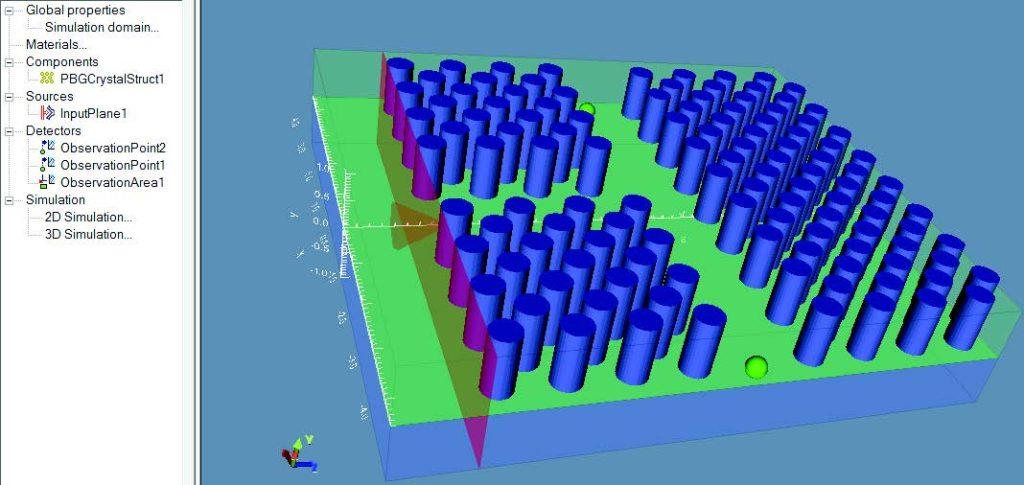
Advanced automation and parameter overviews
OptiFDTD designs and nonlinear photonics simulations can be fully automated using the powerful Visual Basic scripting language. The language is easy to learn and offers standard programming structures such as objects, loops, and conditionals. Parameter sweeps provide an intuitive graphical interface for defining parametric simulations in which one or two parameters change with each iteration. OptiFDTD post-processing tools leverage automation features to support design optimization.
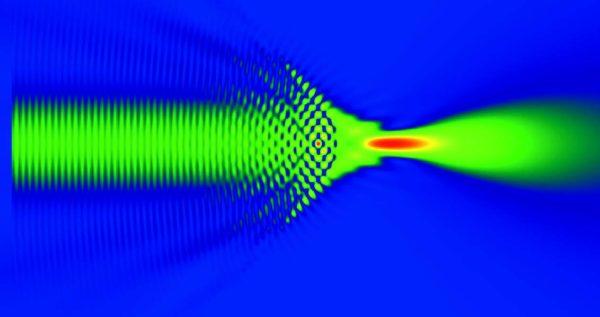
Solution of equations by plane wave expansion method for photonic crystals
The integrated 2D PWE band solver and photonic crystal editor in our FDTD program enable design and simulation of any photonic crystal structure (1D, 2D, 3D). The PWE band solver scans the k-space, following the irreducible Brillouin zone to find the natural frequencies of the given structure. Band gaps are automatically determined on the generated band diagram.
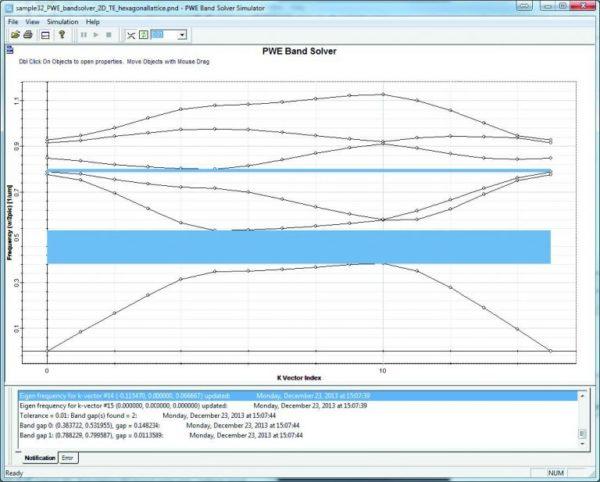
Advanced post-process simulation tools
Program OptiFDTD oferuje również rozbudowane narzędzia do analizy symulacji. Za pomocą OptiFDTD Analyzer można obserwować ewolucję amplitudy, fazy oraz rzeczywistych lub urojonych wartości dowolnych składowych pola w domenie czasowej i częstotliwościowej (przy użyciu transformacji FFT lub DFT) zarejestrowanych przez detektory. Wszystkie dane mogą być eksportowane do zewnętrznych narzędzi, takich jak Matlab™ czy Origin™ w celu dalszej obróbki lub publikacji.
Ewolucję pól w czasie można również wizualizować w postaci filmów. OptiFDTD Analyzer i OptiFDTD Toolbox pozwalają na obliczenia rozkładu mocy spolaryzowanej, wektorów Poyntinga, całek nakładania, absorpcji ciepła oraz transformacji dalekiego pola.
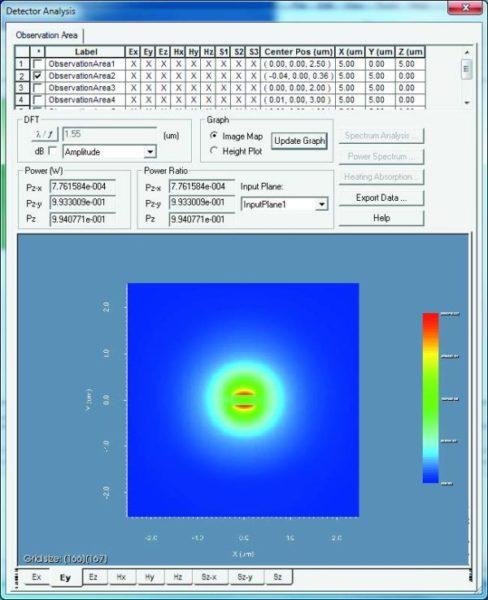
Efficiency
OptiFDTD w pełni wykorzystuje możliwości nowoczesnych 64-bitowych systemów operacyjnych i procesorów. Program OptiFDTD został zoptymalizowany do efektywnego działania na wielu rdzeniach i procesorach w jednym komputerze, korzystając z pamięci współdzielonej, co zapewnia maksymalną wydajność przy minimalnym zużyciu pamięci (w porównaniu do architektur rozproszonej pamięci, takich jak MPI).
W przypadku symulacji wymagających dużej ilości pamięci, dostępny jest silnik symulacji 3D na system Linux, zaprojektowany specjalnie z myślą o wykorzystaniu klastrów komputerowych do symulacji fotoniki nieliniowej.
Interface with popular design tools
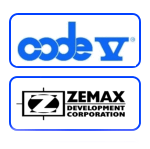
OptiFDTD Characteristics
- Waveguide mode input using OptiMode
- Gaussian beam input
- Plane-wave
- Point source (dipole)
- Single wavelength (CW) source
- Pulsed source
- Linear or circular polarizations
- Simulation of multiple sources simultaneously
- Dielectric (lossless and lossy) material, (n,k) direct entry, or Sellmeier model for glasses
Isotropic or anisotropic media - Dispersive (Lorentz, Drude and Lorentz-Drude)
- Nonlinear photonics media (2nd, 3rd order, Kerr and Raman)
- Perfect conductor material
- Extensive Material Library
- Uniaxial Perfectly Matched Layers (UPML)
- Perfect Electric Conductor (PEC)
- Perfect Magnetic Conductor (PMC)
- Periodic Boundary Conditions (PBC)
- Straight and titled waveguides with taper function
- Ring, arc, circle, and ellipse waveguides with taper
- Parabolic and exponential waveguides with taper
- 3D shapes with clipping functions
- Photonic crystal lattice editor
- Import from 3rd party CAD layout software
- Export masks for lithography
- 2D TM or TE, 3D simulations
- FDTD program supports non-uniform meshing capabilities
- PWE band solver for photonic crystals
- Full 64-bit simulation, Multithreaded engine
- Cluster computing: hybrid multithreading / MPI engine on Linux clusters
- Point detector (temporal and spectral)
- Line and area detectors (DFT spectra)
- Mode analysis
- Poynting vector analysis
- Polarized power analysis
- Far-field transform
- Fields exported to text, images, or movies
Video – Discover OptiFDTD
0:23 Silver Slab Wavelength
0:53 Simulation
1:58 Sub-Wavelength Aperture
OptiFDTD Applications
Below is a list of selected scientific publications, technical journals, periodicals and conference proceedings that refer to the use of OptiFDTD software. These references have been collected from internal sources, articles submitted by customers and scientific publications from Google Scholar. To the best of our knowledge, all of these works use the OptiFDTD software package. If you notice any errors, please contact us immediately at info@spectropol.pl or info@optiwave.com.
- Metasurface integrated in thin solar cells for index modulation https://www.spiedigitallibrary.org/proceedings/Download?urlId=10.1117%2F12.2643267
- A low loss hexagonal six-port optical circulator using silicon photonic crystal https://doi.org/10.1007/s11082-023-05335-1
- Design and Optimization of 2D Photonic Crystal Based Compact All Optical T Splitter for Photonic Integrated Circuits https://www.jpier.org/PIERM/pier.php?paper=23080801
- Design of 2D photonic crystal biosensor for HIV detection using Nano cavity and micro cavity based structure”, researchgate.net, https://www.researchgate.net/profile/Vijay-Kalyani/publication/372493850_Design_of_2D_photonic_crystal_biosensor_for_HIV_detection_using_Nano_cavity_and_micro_cavity_based_structure/links/64ba45f58de7ed28bab421af/Design-of-2D-photonic-crystal-biosensor-for-HIV-detection-using-Nano-cavity-and-micro-cavity-based-structure.pdf
- Temperature-Dependent Anisotropic Refractive Index in β-Ga2O3: Application in Interferometric Thermometers https://www.mdpi.com/2079-4991/13/6/1126
- High Sensitivity Refractive Index Sensor Based on Two-Dimensional Photonic Crystal for Chikungunya Virus https://essuir.sumdu.edu.ua/handle/123456789/93356
- Effect of electronic and phonon properties on polar dielectric embedded polymer-based radiative cooling materials https://www.sciencedirect.com/science/article/pii/S0927024823002945
- Modelling and performance analysis of ring resonator-based refractive-index sensor for bacterial water detection https://doi.org/10.1007/s11082-022-04507-9
- Simulation and excitation analysis of nano aperture-array for surface plasmon based memory applications https://doi.org/10.1007/s41870-022-01100-x
- Effective index approximation based analytical modeling and two dimensional numerical investigation of surface and bulk sensitivity in optimized hybrid … https://doi.org/10.1007/s11082-023-04592-4
- Fano Resonance enhanced Refractive Index sensing using Arc based Plasmonics Resonator https://ieeexplore.ieee.org/abstract/document/10308591/
- Effective Refractive Index for Nano-sized Metal Array Medium https://doi.org/10.3938/NPSM.73.196
- High performance infrared selective emissivity film tailored for thermal-stable camouflage https://www.sciencedirect.com/science/article/pii/S0030401823004911
- Micro/nano-structuring assisted efficiency improvement of organic light emitting diodes https://doi.org/10.1063/5.0114417
- The comparative analysis of 2D photonic crystals applications based on specific modeling/simulation results https://doi.org/10.1117/12.2665488.short
- Refractive Index Fiber Laser Sensor by Using a Fiber Ball Lens Interferometer with Adjustable Free Spectral Range https://www.mdpi.com/1424-8220/23/6/3045
- Photonic integrated cmos-compatible true time delay based broadband beamformer https://doi.org/10.1007/s11082-023-05492-3
- Two-dimensional photonic crystal based optical CNOT gate https://doi.org/10.1007/s11082-023-05228-3
- A 2D GaAs-Based Photonic Crystal Biosensor for Malaria Detection https://search.ebscohost.com/login.aspx?direct=true&profile=ehost&scope=site&authtype=crawler&jrnl=22235329&AN=172767238&h=lZt0j6uqvf0CpHJJnO7n%2B%2B7A7E%2FljwlK%2B1%2B%2Bx1I5lq8Iz84699PjmxJCvdOm9joWq0ODIuY1E%2FytkxoPS5o2VQ%3D%3D&crl=c
- Plasmonic field-regulating characteristics of alloy-based multilaminar films in 300–800 nm https://www.cell.com/heliyon/pdf/S2405-8440(23)00291-8.pdf
- A Gallium arsenide composite semi-conductive material-based 2D photonic crystal biosensor for cancer cell detection https://doi.org/10.1007/s11082-023-05281-y
- Enhancing photon collection from single shallow nitrogen-vacancy centers in diamond nanopillars for quantum heterodyne measurements https://doi.org/10.35848/1882-0786/acede9
- Dimensional Photonic Crystal Biosensor Based on Gallium Arsenide Composite Semi-conductive Material for Diabetes Detection https://doi.org/10.1007/s11468-023-01857-2
- Analysis the Linear Optical Constant of Lanthanum Doped Nickel Ferrites Nanoparticles from Absorption Spectra https://www.ijarst.in/public/uploads/paper/359531684825519.pdf
- Design and Analysis of All-Optical Logic Gates Based on a Germanium Dielectric Material Micro Ring Resonator Using Photonics Crystal Technology https://www.iarj.in/index.php/ijrase/article/view/170
- Design and Analysis of 2D Photonic Biosensor with ML for Respiratory Virus Detection https://nopr.niscpr.res.in/handle/123456789/62914
- Design and Analysis of 2D Photonic Biosensor with ML for Respiratory Virus Detection: BIOSENSOR WITH ML FOR RESPIRATORY VIRUS DETECTION https://or.niscpr.res.in/index.php/IJEMS/article/view/2520
- A review of different techniques used to design photonic crystal-based logic gates https://www.sciencedirect.com/science/article/pii/S0030402623002905
- Enhancing Room-temperature Photoluminescence from Erbium-doped Silicon by Fabricating Nanopillars in a Silicon-on-Insulator Layer https://www.jstage.jst.go.jp/article/ejssnt/advpub/0/advpub_2023-041/_article/-char/ja/
- Four-Arm Grating Couplers for Wavefront Sensing Applications https://macsphere.mcmaster.ca/handle/11375/29050
- Two-Dimensional Photonic Crystal Based Four-channel Demultiplexer in Graphene for Applications DWDM” https://www.researchsquare.com/article/rs-3361647/latest
- Design of linear block code encoder and decoder using electro-optical and all-optical units https://doi.org/10.1515/joc-2019-0085
- Light scattering properties of cellulose microcrystals from multiple angles under a magnetic field https://content.iospress.com/articles/international-journal-of-applied-electromagnetics-and-mechanics/jae220172
- Implementing commercial inverse design tools for compact, phase-encoded, plasmonic digital logic devices https://doi.org/10.1117/1.JNP.17.016011.short
- Optimization of Electrode, Interlayer and Absorber Layers of a Gr/ReS2/PSi/p-cSi Photovoltaic Solar Cell with SCAPS https://doi.org/10.1007/s11664-023-10415-9
- Photonic Crystal Flip-Flops: Recent Developments in All Optical Memory Components https://www.mdpi.com/1996-1944/16/19/6467
- New designs of 4× 2 photonic crystal encoders using ring resonators https://doi.org/10.1007/s11082-022-04506-w
- Enhancing the Photocatalytic Performance of Antibiotics Using a Z-Scheme Heterojunction of 0D ZnIn2S4 Quantum Dots and 3D Hierarchical Inverse Opal https://www.mdpi.com/1420-3049/28/20/7174
- Synergistically Enhanced Photocatalytic Degradation by Coupling Slow-Photon Effect with Z-Scheme Charge Transfer in CdS QDs/IO-TiO2 Heterojunction https://www.mdpi.com/1420-3049/28/14/5437
- A Y-shaped photonic integrated device with XNOR/NAND/NOR for optical signal processing https://doi.org/10.1007/s11082-023-05068-1
- Photonic crystal-based tristate phase shift quantum gates using joint encoding of frequency and phase https://doi.org/10.1007/s12596-023-01439-9
- Enhanced Light Extraction of Nano‐Light‐Emitting Diodes with Metal‐Clad Structure Using Vertical GaAs/GaAsP Core–Multishell Nanowires on Si Platform https://doi.org/10.1002/adpr.202200337
- Toward the Scaling up of Daytime Radiative Coolers: A Review https://doi.org/10.1002/adom.202300123
- Toward the Scaling up of Daytime Radiative Coolers: A https://d-nb.info/130307396X/34
- On the potential of cool materials in the urban heat island context: Scalability challenges and technological setbacks towards building decarbonization https://www.sciencedirect.com/science/article/pii/S0378778823005601
Free trial
Take advantage of the 30-day opportunity to test the Optiwave software. Sign up now!
